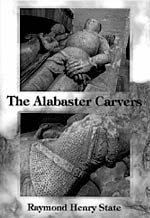Book reviews, Winter 2017
The Alabaster Carvers
By Raymond Henry State
Melrose Books 2017 ISBN 9781912026128. £39.99

The East Midlands, is of course well known as the primary location for the quarrying and carving of alabaster (a form of gypsum) in the mediaeval and post-mediaeval period, although Nottingham itself, State argues, was not a centre for large effigy carving, focusing instead on smaller panels. The products of this important industry were exported throughout Britain and across Europe; today, its primary surviving relics are funerary monuments and effigies which adorn a great number of cathedrals and churches up and down the country. This major new work of synthesis brings together a huge range of both physical and documentary evidence for the quarrying, trade, commissioning and carving of alabaster monuments and the lives and work of ‘the kervers’.
The opening chapters outline the locations of the quarries, the nature of the industry, and establish the chronological development of tomb production from a relatively small-scale output in the middle ages rising to a peak in the late sixteenth and early seventeenth century. The work then moves on to present the main types of monument, with a discussion of their changing form, style and symbolism and the social and religious context of their production across the period from the later middle ages to the post-Reformation period.
This is supported by an impressive series of appendices, which together make up the major part of the book, providing a detailed list of known craftsmen working in each region across the period between the fourteenth and seventeenth century and a gazetteer of over 2,000 known alabaster monuments ordered chronologically and geographically with a wealth of supporting information. This monumental work - in every sense - will be an essential guide for anyone seeking to understand these fascinating and beautiful witnesses to the mediaeval and early modern past.
Dr Chris King, University of Nottingham
Burgage Manor Revealed: A Community Archaeology project exploring the Burgage in Southwell
Southwell Community Archaeology Group. £5, available from Southwell Library, King Street, Southwell or by post (+ postage) by contacting info@southwellarchaeology.org
This account of the investigation carried out by the Southwell Community Archaeology Group, under its chairman John Lock, to discover more about the past of the Burgage is presented in a beautifully produced book full of richly coloured photographs, plans, maps and diagrams which bring the text to life.
After a foreword by John Lock tracing the background to the project and acknowledging the contributions made by many individuals and groups, the story is continued in more detail with introductory notes about the Burgage and some of its associated buildings, the indications of interesting material beneath its surface and reproductions of the various surveys that guided the planning of the digs.
The excavations in several trenches on the Small Green and the Main Green and test pits in various nearby gardens are described concisely and clearly, with helpful illustrations. In the next section we are given a vivid overview of some of the more striking finds from the excavations, such as the Southwell green glaze pot, of which a sufficient number of fragments were found to enable an expert to reconstruct much of it, some pieces of clay pipes whose makers could be traced and a metal seal from the 13th century bearing the image of an eagle with wings outstretched.
The next section is devoted to ‘new understandings of the story of the Burgage’ and summarises the adjusted perspectives that the results of the project have brought to the history of this area, from the 12th to the 19th centuries.
In the final part of the book tribute is paid to the involvement of the community, from primary school children to the team of dedicated diggers - and it is evident that all participants and visitors enjoyed the enterprise immensely and that good humour prevailed even when conditions were wet and muddy.
This slender volume is full of fascinating information set out with exemplary clarity and plenty of illustrative material. This reviewer would, however, have welcomed definitions of ‘burgage’ and burgage plot’, terms which are central to the project, and also an indication of what kind of survey produced the greyscale plan accompanying the photograph of the excavations on the Small Green. Finally, it is clear that this admirable book could only showcase the main features of the excavations and their results; it whets the appetite for a more detailed presentation of the project which, it is to be hoped, will be forthcoming before too long.
If you live in Southwell or just enjoy visiting, this is a volume which will enhance your knowledge of part of the town and your admiration of its community spirit. It is warmly recommended.
Janet Wilson